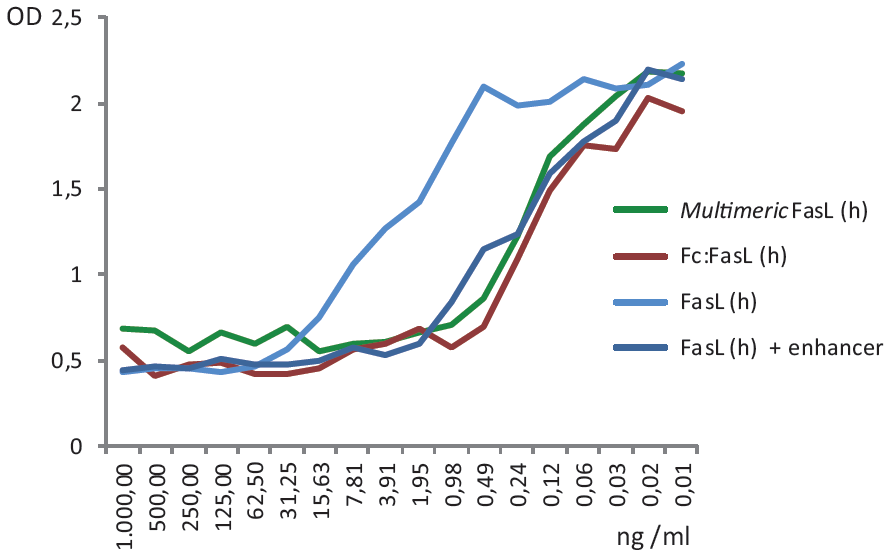FasL (human) (multimeric) (rec.)
Product Code:
AG-40B-0130
AG-40B-0130
Host Type:
Human
Human
Regulatory Status:
RUO
RUO
Target Species:
- Human
- Mouse
Shipping:
Blue Ice
Blue Ice
Storage:
-20°C
-20°C
No additional charges, what you see is what you pay! *
| Code | Size | Price |
|---|
| AG-40B-0130-C010 | 10 ug | £300.00 |
Quantity:
| AG-40B-0130-3010 | 3 x 10 ug | £590.00 |
Quantity:
Prices exclude any Taxes / VAT
Stay in control of your spending. These prices have no additional charges, not even shipping!
* Rare exceptions are clearly labelled (only 0.14% of items!).
* Rare exceptions are clearly labelled (only 0.14% of items!).
Multibuy discounts available! Contact us to find what you can save.
This product comes from: Switzerland.
Typical lead time: 7-10 working days.
Contact us for more accurate information.
Typical lead time: 7-10 working days.
Contact us for more accurate information.
- Further Information
- Documents
- References
- Related Products
- Show All
Further Information
Alternate Names/Synonyms:
MultimericFasL™; MegaFasL; ACRP30headless:APO-1L; ACRP30headless:CD95L; ACRP30headless:CD178; ACRP30headless:TNFSF6; ACRP30headless:Fas Ligand
Biological Activity:
Induces apoptosis of human Jurkat T cells at a concentration of <0.2ng/ml.
Concentration:
0.1mg/ml after reconstitution.
EClass:
32160000
Endotoxin:
<0.02EU/µg purified protein (LAL test).
Form (Short):
liquid
Formulation:
Lyophilized. Contains PBS.
Handling Advice:
After reconstitution, prepare aliquots and store at -20°C.Avoid freeze/thaw cycles.Centrifuge lyophilized vial before opening and reconstitution.PBS containing at least 0.1% BSA should be used for further dilutions.
Long Description:
Protein. Human FasL (aa 139-281) is fused at the N-terminus to mouse ACRP30headless (aa 18-111) and a FLAG®-tag. Source: HEK 293 cells. Endotoxin content: <0.02EU/µg purified protein (LAL test; Lonza). Lyophilized. Contains PBS. Binds to human and mouse Fas. Purity: >95% (SDS-PAGE). MultimericFasL™ is a high activity construct in which two trimeric FasL are artificially linked via the collagen domain of ACRP30. This construct very effectively mimics the natural membrane-assisted aggregation of FasL in vivo. FasL is a cytokine that binds to TNFRSF6/Fas, a receptor that transduces the apoptotic signal into cells. It is involved in cytotoxic T cell mediated apoptosis and in T cell development.
Molecular Weight:
~40kDa (SDS-PAGE)
NCBI, Uniprot Number:
P48023
Package Type:
Plastic Vial
Product Description:
MultimericFasL™ is a high activity construct in which two trimeric FasL are artificially linked via the collagen domain of ACRP30. This construct very effectively mimics the natural membrane-assisted aggregation of FasL in vivo. FasL is a cytokine that binds to TNFRSF6/Fas, a receptor that transduces the apoptotic signal into cells. It is involved in cytotoxic T cell mediated apoptosis and in T cell development. FasL treatment of stem cells is a robust method for proliferating cells in culture while improving their stemness properties. Treatment with FasL results in a large quantity of Adipose Derived Stem Cells (ASC) of high quality.
Purity:
>95% (SDS-PAGE)
Sequence:
Human FasL (aa 139-281) is fused at the N-terminus to mouse ACRP30headless (aa 18-111) and a FLAG®-tag.
Source / Host:
HEK 293 cells
Specificity:
Binds to human and mouse Fas.
TAGs:
FLAG
Transportation:
Non-hazardous
UNSPSC Category:
Other Proteins
UNSPSC Number:
12352202
Use & Stability:
Stable for at least 6 months after receipt when stored at -20°C. Working aliquots are stable for up to 3 months when stored at -20°C.
References
Two adjacent trimeric Fas ligands are required for Fas signaling and formation of a death-inducing signaling complex: N. Holler, et al.; Mol. Cell. Biol. 23, 1428 (2003) | A Fas agonist induces high levels of apoptosis in haematological malignancies: P. Greaney, et al.; Leuk. Res. 30, 415 (2006) | Apograft, a Novel Stem Cell Selection Technology, Prevents Graft vs. Host Disease (GvHD) While Preserving Graft vs Leukemia (GvL) Effects: J. Stein, et al.; Biol. Blood Marrow Transplant. 24, 192 (2018) | ASC- and caspase-8-dependent apoptotic pathway diverges from the NLRC4 inflammasome in macrophages: B.L. Lee, et al.; Sci. Rep. 8, 3788 (2018) | Fas Promotes T Helper 17 Cell Differentiation and Inhibits T Helper 1 Cell Development by Binding and Sequestering Transcription Factor STAT1: G. Meyer zu Horste, et al.; Immunity 48, 556 (2018) | Fas-L promotes the stem cell potency of adipose-derived mesenchymal cells: I. Solodeev, et al.; Cell Death Dis. 9, 695 (2018) | IRF2 transcriptionally induces GSDMD expression for pyroptosis: N. Kayagaki, et al.; Sci. Signal. 12, eaax4917 (2019) | Brief ex vivo Fas-ligand incubation attenuates GvHD without compromising stem cell graft performance: H. Levy-Barazany, et al.; Bone Marrow Transplant. 55, 1305 (2020) | NINJ1 mediates plasma membrane rupture during lytic cell death: N. Kayagaki, et al.; Nature 591, 131 (2021) | FasL Promotes Proliferation and Delays Differentiation of ASCs: I. Sarel, et al.; Jpn. J. Med. 4, 474 (2021) | Fas-threshold signalling in MSCs promotes pancreatic cancer progression and metastasis: A. Mohr, et al.; Cancer Lett. 519, 63 (2021) | Smac mimetics and TRAIL cooperate to induce MLKL-dependent necroptosis in Burkitt?s lymphoma cell lines: A. Koch, et al. Neoplasia 23, 539 (2021)
Related Products
| Product Name | Product Code | Supplier | anti-Fas (human), mAb (APO-1-3) (preservative free) | AG-20B-0062PF | AdipoGen Life Sciences | Summary Details | |||||||||||||||||||||||||||||||||||||||||||||||||||||||||||||||||||||||||||||||||||||||||||||
|---|---|---|---|---|---|---|---|---|---|---|---|---|---|---|---|---|---|---|---|---|---|---|---|---|---|---|---|---|---|---|---|---|---|---|---|---|---|---|---|---|---|---|---|---|---|---|---|---|---|---|---|---|---|---|---|---|---|---|---|---|---|---|---|---|---|---|---|---|---|---|---|---|---|---|---|---|---|---|---|---|---|---|---|---|---|---|---|---|---|---|---|---|---|---|---|---|---|---|---|
| Fas (human):Fc (human) (rec.) (MultiPack) | AG-40B-0082 | AdipoGen Life Sciences | Summary Details | ||||||||||||||||||||||||||||||||||||||||||||||||||||||||||||||||||||||||||||||||||||||||||||||||
| CD95 [Fas] (human)-huIg Fusion Protein | ANC-506-020 | Ancell | Summary Details | ||||||||||||||||||||||||||||||||||||||||||||||||||||||||||||||||||||||||||||||||||||||||||||||||
| CD95 [Fas] (human)-huIg Fusion Protein (Biotin) | ANC-506-030 | Ancell | Summary Details | ||||||||||||||||||||||||||||||||||||||||||||||||||||||||||||||||||||||||||||||||||||||||||||||||
| CD95 [Fas] (human)-huIg Fusion Protein (preservative free) | ANC-506-820 | Ancell | Summary Details | ||||||||||||||||||||||||||||||||||||||||||||||||||||||||||||||||||||||||||||||||||||||||||||||||



